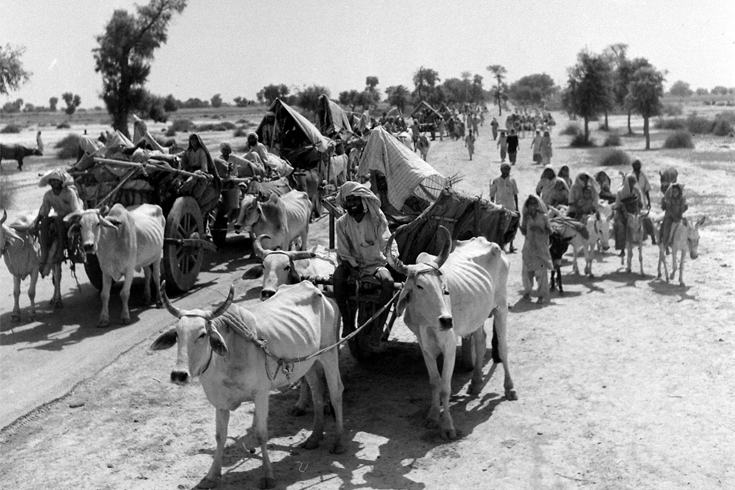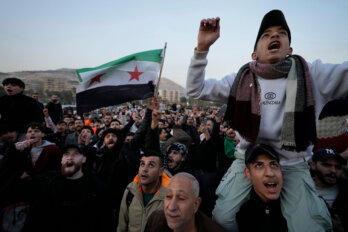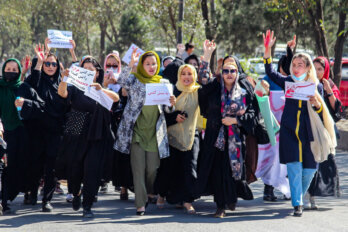In the spring of 2019, I went to a travelling Frida Kahlo exhibit at the Brooklyn Museum entitled Appearances Can Be Deceiving, which seemed so fitting to my overall project. I was writing about people, times, and subjects I knew little about (my parents, the Partition of India and Pakistan, partitions in the mathematical theory of sets), uncovering the many veils of my own identity, and questioning several one-sided truths (the project was part biography, part autobiography, part history of India, part history of Canada, part science, part philosophy of science). The exhibit displayed Kahlo’s artwork, her lipsticks, her diaries, her medical history, her medicines, her casts, her corsets, her dresses, and her shoes, together telling a fractured story of her life.
But it was one pair of shoes in particular I was there for. I’d come across a photograph on the internet of pink silk ankle boots, beautiful and asymmetric, one heel about two times higher than the other. This photo of Kahlo’s shoes sent a shiver down my spine because they have the same asymmetric silhouette as my father’s boots. I had been writing, in part, about my father, who contracted polio as an infant in pre-Partition Punjab. As an adult, he had his shoes custom made in New Delhi during one of the infrequent trips we made there, together as a family, when I was growing up. I had never seen them as objects; they told a story in and of themselves.
Before the bus accident that left Kahlo bedridden in a body cast, her pelvis, spine, collarbone, and ribs broken, she, too, contracted polio, though at the age of six in Mexico. Finding and pursuing synchronicity between unrelated events, like the fact that both my father and Kahlo had childhood polio, had polio shoes, is how I pursued the writing of my book. I had a hunch that travelling to New York City for the sole purpose of seeing Kahlo’s shoes would shed light on my understanding of several things: probability, asymmetry, and viruses—all themes that I had been meditating on while writing my book.
I originally intended not to write anything of myself but to tell only the stories of my parents’ lives and of some other people in their generation. But, in writing their stories, I realized very quickly that I could not tell their stories in the third person and be done with it. I felt I had to inhabit their worlds, to wear their clothes, to walk in their shoes, to imagine their thoughts, to read their books (quantum physics in the case of my father, ESL books in the case of my mother). I had to become them. I had to write “I.”
What follows is an excerpt from the first section of my book, written in my father’s voice.
In 1947, a line is drawn across the state of Punjab. The man who draws it imagines an organic, undulating curve, like a river. What cannot be seen is how it changes course every year. If a river cuts the left bank, it deposits silt on the right. And vice versa. Punjab means “five rivers.” Adding a line like a river by hand on a map does not seem unreasonable. His little arrows indicating human displacement are impeccable.
By that point in history, scientists have discovered infrared radiation, galactic red shifts, and continental drift. There is already a model of the atom, the theory of the big bang, and penicillin. But maps are still of very poor resolution. What cannot be seen are fenceless farmers’ fields, entwined bodies of lovers, birds nesting. Superconductivity has been discovered, but there is still no known mechanism to trigger the amplification of electrical currents without the input of a human hand, the flicking of a switch.
With the flick of a man’s wrist, India ink is spilled, and there is no way to predict how much of that dark blue will become blood red. People begin to sew gold into their inner pockets. As they flee, some of that gold will make contact with the women to whom it belongs, but most of it will be torn from bloodied bodies or scavenged from funeral pyres. Those who go unnoticed are lucky, rare as lottery winners. In December of that same year, at Bell Laboratories, a scientist named Walter Brattain will attach a strip of gold foil over the point of a plastic triangle. He will take a razor blade and slice through the gold metal at the tip to create two points of contact, a mere hair-width apart. He will place the triangle over a crystal of semiconductor, a metal that either allows current through or not, depending on its charge. He will place all this on a source of voltage and thus invent the first point-contact transistor. It will have the capacity to make a little current not just alter the flow of a larger current but amplify it. Like drawing a red line on a black-and-white map.
From then on, transistor technology will double in capacity every two years. In the future, everyone will have it. A cellphone will have 100 million transistors in it. A laptop computer, over a billion. That is perhaps one way to think of how many people will be affected by Partition.
In 1939, before Partition, my pregnant mother must travel thousands of kilometres from Delhi back to her in-laws’ home in Mong—the reverse trajectory that millions of Hindus will take eight years later—to give birth to me, her eldest son. I spend the first few months of my life there, on the wrong side of the future Radcliffe Line. It is therefore impossible to say where it happens. But, sometime before I turn one, a small virus enters my mouth. It multiplies with identical copies and spreads to my tonsils, then to my lymph nodes. This process takes many days, weeks. Most people never know they have become infectious. The virus stops spreading within them, asymptomatically. But, in my case, by chance—which I will later learn is one in 1,000—the virus enters my central nervous system. I get a fever, a headache, stiffness in my back and neck; I have difficulty swallowing and lose some of my reflexes. Then the virus begins to destroy my motor neurons. Within a few days, the muscles in my left leg stop receiving signals from my brain and spinal cord. The leg is weak and floppy. No one will notice.
If it happens while my mother and I are visiting my grandparents in Mong, my grandfather is too busy loaning money to Muslim farmers who will take innumerable generations to pay him back. If the virus enters in our new home in Delhi, my mother is too blinded by my fair face and by the fact that I am a boy. When I have trouble learning how to walk, the doctor says it is too late for anything.
You are lucky he is not dead, says the doctor to my father. A white man at my father’s office tells him about the invention of the iron lung. Negative pressure ventilator, mechanical respirator, words my father has never heard before. He is not a scientist. It could be worse, the white man says.
My grandfather is a known entity by the local British government, especially the finance commissioner of Punjab, because he is the biggest moneylender in the village of Mong. There are often disputes. People do not pay their loans and many suits are filed. Whenever they want to authenticate incidents on the ground, they call my grandfather.
He has developed an affection for the British. It is not clear whether the mutual trust is due to the exploitation of peasant farmers, which benefited both, or genuine goodwill.
During Partition, sons of a Muslim neighbour rob Hindus in an adjacent village. They end up killing somebody. My grandfather goes as a witness to the court and says the boys were with him during the attack. The sons are spared.
When Muslims from outside our village come with weapons to force Hindus to leave, the spared sons load up all my grandfather’s things on donkeys and take the family to a refugee camp. The headlines in the paper the next day inform us that poison was mixed into the food that was served at the camp. Over 80 percent of the people die. We conclude, based on this probability, that the rest of our family is dead.
A few weeks later, my grandfather, my grandmother, and all my uncles and aunts arrive on our doorstep in Delhi with nothing but their clothes. The night of the poisoning, the spared Muslim sons entered the refugee camp disguised as Hindus, told our family not to eat or drink anything from the camp, and brought them food and milk. My grandfather lied to the British to save some Muslims. I realized then that he trusted the Muslims more. They owed him a debt that they continued to honour.
In 1956, I write my final exams. The day the results come, I am sleeping under the stars because it is too hot in the house with all my seven siblings there. The results are published in the newspaper.
No one in my family has ever gotten first class. No one in the neighbourhood has. When father hears that I have, he shouts, “Why are you not the absolute top?” and slaps me. He wants me to be not just first class but first out of the 1,000 students.
Our next-door neighbour acts more like a father to me: he starts to call me “Principal” from then on. It is he who comes with me to hear Jawaharlal Nehru give a speech. Nehru is speaking in English. Thousands of people are listening. Our next-door neighbour says, “Yah, yah, hunh, hunh!” I ask him if he understands English and he says, “If everyone is saying hunh, hunh, they can’t every one of them be foolish!”
I am enrolled in the most prestigious physics undergraduate program in India. On graduation morning, it is raining. Huge tents are put up around the campus. Everyone’s parents are there except mine. Later, in the hot afternoon sun, I taste the salt of dried tears. Sometimes getting an answer is as simple as weighing a thing before and after evaporation.
I start teaching at a college for aristocratic girls. Many of them flirt with me. One of the girls I tutor at her home is the daughter of the railway minister. I tell her, “Listen, if your father finds out, he is going to open up a grave right here and bury me and no one will know.” Another is the daughter of one of the biggest industrialists of the cement company Dalmia. The daughter insists we go boating on the pond at India Gate. We are oblivious to the 13,218 engraved names of Indian soldiers who fell in the First World War. I could marry her, easily, I think, but I do not dare to return her advances because we are not in the same caste. She wears gold. I wear silver. No contact.
I do not remember what puts the idea of emigration into my head, but I get a visa before I even have a passport. I learn right then that life is like that, that it sometimes makes sense to put the cart before the horse, the song before the music lessons, the ink before the blood. Because the embassy happens to be on the way to my uncle’s house, I get a Canadian visa. There is a Globe and Mail paper lying in the office. I read that there is a shortage of teachers in Canada. A white man comes in and says, “Hey, are you a teacher? We need teachers.” He gives me the forms to fill out.
My mother wants me to get married before leaving. I am twenty-eight, which is already too old. I marry the first person they present to me. I tell my newlywed I must leave three weeks after the wedding. She will stay behind with my family until I find a job. The Indian government gives me $8 Canadian and a $200 draft to be repaid upon repatriation. They give me two sets of clothes and a Nehru jacket. I arrive in Montreal in December 1967. As the flight descends, I look out the window. The night is electrified by the bright lights of the city. In the short walk from the airplane to the terminal, I slip and fall on the ice. The gold of my wedding ring makes contact with the tarmac. Someone rushes to give me his left hand. Two points of contact, a mere hair-width apart, like in the experiment that led to the first transistor. This gesture will have the capacity to make a little current not just alter the flow of a larger one but amplify it.
Excerpted from This Red Line Goes Straight to Your Heart by Madhur Anand. Copyright © 2020 Madhur Anand. Published by Strange Light/McClelland & Stewart, a division of Penguin Random House Canada Limited. Reproduced by arrangement with the publisher. All rights reserved.




